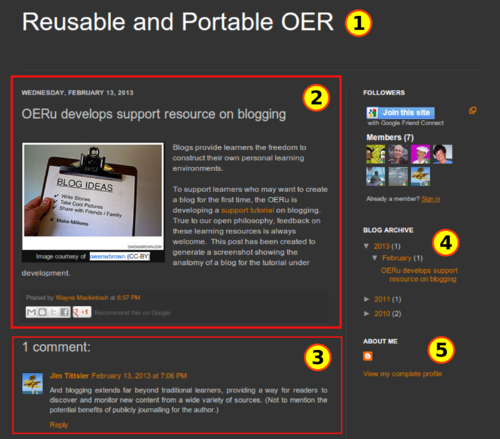Anatomy of a blog
Contents
Exploring a few blog sites
In this subsection we will explore a few blog sites to identify the structural components and features used by blogs.
Comparing the structure and components of educational blog sites
|
The components of a blog site
In this section we summarise the components of a standard blog site and the corresponding functions of these elements. Many blogs provide users the ability to customise the theme and layout of their site and consequently the placement of standard blog components may differ from blog to blog. You may need look around the site to find the link or component you are looking for.
Blog name
The name or title of a blog is usually displayed at the top of the website (see No. 1 in Figure 1). The blog name or image logo functions as a hyperlink to the front page of the blog.
Posts
Individual posts are the lifeblood of a blog (see No. 2 in Figure 1). New posts are normally added at the top of the main page, unlike a standard website where content is posted according to the navigational hierarchy of the site. Most blogging software includes the ability for the blogger to add categories which provides the ability to associate and find previous posts by category and date. Older posts are moved to an archive (see below).
Pages
About, Contact, are static information are pages with data that doesn't change often. Instead of creating a post, a page can be created for important information such as the about information.
Comments
Visitors to a blog are typically allowed to provide comments on posts (See No. 3 in Figure 1). The original author often joins in the conversion by replying to comments on their blog. The comment feature is a unique aspect of blogging which allows authors to connect with their readers on what they are writing.
Blogging software provides the ability to disable the comment feature on posts. Bloggers also have the ability to moderate posts and approve the comment before it appears on published site, or alternatively allow comments without moderation. This is a personal decision of the blogger. Unmoderated comments allow for immediate posting and flow of information, but carry the risk of potential SPAM or offensive comments. On the other hand, moderation may result in long delays before comments are published on the site, for example receiving comments from different time zones when the blogger is not attending to the site. However, moderation is an effective way to manage SPAM (which may slip through the standard spam protections) and minimise the risk of offensive comments before being posted live on the website. Note that blogging software provides the ability for the registered users to delete offensive comments after they have been posted.
Blog archive
The blog archive provides a history of all the posts on the blog (see No. 4 in Figure 1). A blog is basically an online diary where individual posts are displayed in reverse chronological order with the most recent post appearing first on the home page.
Visitors can access the archive by date, or if implemented, categories (also called display labels) the blogger applies to individual posts. When applied, the categories are usually listed at the bottom of the post and the archive of posts can also be listed by category. Many blogs have the feature to include a category feed as a footer or sidebar option.
About link
The name of a blog does not necessarily convey the identity of the blogger or bloggers posting to a shared site. To find out more about the identity, interests and association of the blogger(s) there is usually an "About link" (or something similar) displayed on the home page (see No. 5 in Figure 1).
About page could display information
- Name/screen name of author
- Biography
- Email contact - media/press/business
- Phone number
- Postal and business physical address
A blog roll
A blog roll is a list of links to different blog sites that the blogger likes or recommends and is usually listed in the sidebar as an optional feature of the blog layout. This is an explicit way of communicating the bloggers circle of interest to the public and sharing blog sites that you enjoy with your readers.
